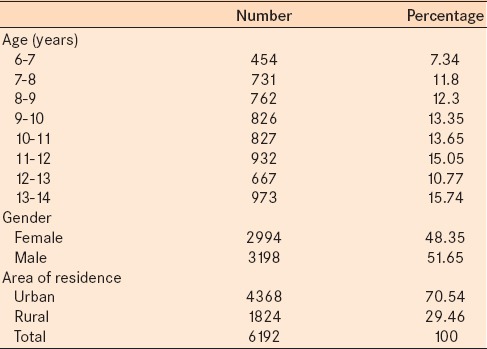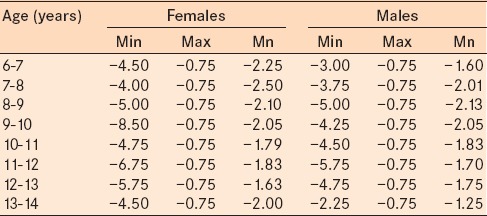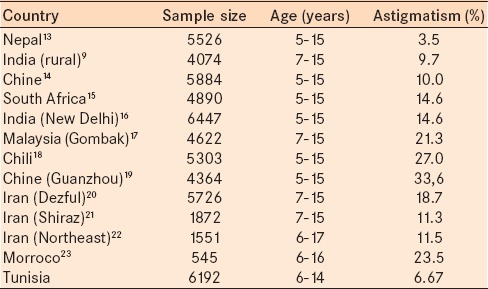Abstract
Purpose:
To evaluate the characteristics of astigmatism in a cross-sectional study of schoolchildren in Tunisia.
Materials and Methods:
A random cluster design was used to recruit children from primary schools across urban and rural settings in Tunisia, from 2008 to 2010. A total of 6192 students aged 6–14-years old were enrolled. All students whose uncorrected visual acuity was worse than 20/20 underwent a complete ophthalmic examination. Astigmatism was defined as the cylinder power of 0.75 diopter (D) or greater.
Results:
The prevalence of astigmatism was 6.67%. Mean cylinder power was - 1.89 ± 0.79D. The prevalence of astigmatism increased statistically significantly with age (P = 0.032). The prevalence of astigmatism was not significantly related to gender (P = 0.051). Of those with cylinder, 63.6%, 17.8%, and 18.6% schoolchildren had with with-the-rule, against-the-rule, and oblique astigmatism, respectively. ATR astigmatism was significantly higher in males (P = 0.033). There was no significant association between the student's area of residence and astigmatism (P = 0.059).
Conclusion:
Comparisons with other studies show that the prevalence of astigmatism in Tunisia is higher than in some countries. The prevalence of astigmatism increased with age but not gender. The majority of schoolchildren had with-the-rule astigmatism.
Keywords: Astigmatism, Prevalence, Schoolchildren, Tunisia
INTRODUCTION
Astigmatism is a common condition in children. It may play an important role in visual development for number reasons. First, some researchers have speculated that persistent astigmatism may distrupt emmetropization by prohibiting the formation of a clear image on the retina.1,2,3,4 Fulton et al.1 have suggested that uncorrected astigmatism early in life could influence the development of myopia. Secondly, infants with higher astigmatism may develop amblyopia.5 Thus, some clinicians view any astigmatism as an urgent reason for refractive intervention. Thirdly, school children are considered a high-risk group because uncorrected refractive errors can seriously affect their learning abilities,6 and their physical and mental development.7 Studies have documented the prevalence of astigmatism in a range of samples, including urban and rural populations8,9 special groups,10,11 and clinic patients.12 Marked differences have been reported in different ethnic groups. The Refractive Error Study in Children (RESC), an international study of refractive error and other visual disorders in school-age children, was designed to assess the prevalence of refractive error and vision impairment in children of different ethnic background and cultural settings.6 Using a standardized study protocol, it is possible to compare studies of patients with different ethnic backgrounds and cultures.
In this study we determined the prevalence of astigmatism in schoolchildren in Tunisia and its relationship with age, gender, and area of residence.
MATERIALS AND METHODS
Study population
The current study is part of the refractive error study on Tunisian schoolchildren, portions of which will be published during preparation of this manuscript. This cross-sectional study was undertaken on Tunisia schoolchildren between January 2008 and June 2010. Twenty-eight public primary schools (clusters) from urban and rural settings were randomly selected and a total of 6192 students aged 6–14-years old were enrolled.
Examination process
Examinations were performed in different classrooms by three ophthalmologists. For all students, monocular distance visual acuity (CDVA) was performed in each eye. According to RESC protocol, a retro-illuminated LogMAR chart with five optotypes on each line was used to test vision. Uncorrected visual acuity (UCVA) was measured (with a LogMAR chart) at a distance of 5 meters. The right eye was tested first, followed by the left eye. The child was requested to indicate the direction of the E by pointing with his/her hand. The lowest line read successfully was assigned as the visual acuity for the eye undergoing testing. All students whose uncorrected visual acuity was worse than 20/20 underwent a complete ophthalmic examination. Three drops of cyclopentolate 1% were administered 5 minutes apart to each eye. Dilating and light reflex were recorded between 45 and 60 minutes after the first drop. Objective refraction with an AR 510 autorefractometer (NIDEK Co. Ltd., Gamagori, Japan) was performed during cycloplegia. After the alignment process, three measurements were taken for each eye. An average of the measurements was produced in printed form.
Definitions
To provide grounds for accurate and valid comparisons with other studies using the RESC protocol, we used the same definition for astigmatism.1 Astigmatism was defined as a cylinder error of 0.75 D or more recorded with a minus sign in at least one eye. On the basis of the astigmatic axis, an axis of 180 ± 30° was classified as with the rule (WTR), an axis of 90 ± 30° was considered against the rule (ATR), and others meridians were considered oblique astigmatism. Astigmatism was categorized as mild (-0.75 D to-1.9 D), moderate (-2.0 D to-3.9 D), and high (greater than-4.0 D).
Ethical issues
This study was approved by the Public Health Ministry. The local school board and school principals also approved the study. Informed consent from a parent or guardian and the consent of each student was obtained before examination.
Statistical analysis
Statistical analyses with the Chi-squared test and the Fischer exact test allowed calculation of the prevalence of astigmatism and the distribution according to age, sex, and area of residence. A value of P < 0.05 was considered statistically significant.
RESULTS
The mean age of the participants was 10.1 ± 1.81 years. Demographic data are presented in Table 1. The prevalence of astigmatism was 6.67% (413 students). Mean and SD of cylinder power was -1.89 ± 0.79 D. Distribution of cylinder refraction by age and gender is shown in Table 2. Mild, moderate, and high astigmatism was seen in 59%, 33.4%, and 7.6% of the subjects, respectively. The prevalence of astigmatism significantly increased with age (P = 0.032). The prevalence of astigmatism was 5.88% in boys and 7.51% in girls. There was no statistically significant difference in gender (P = 0.051). The prevalence of astigmatism was 4.27% in rural areas and 7.67% in urban areas. There was no significant association between the students area of residence and astigmatism (P = 0.059).
Table 1.
Distribution of the study participants in terms of age, gender and area of residence

Table 2.
Cylinder refraction by age and gender

The prevalence of WTR, ATR and oblique astigmatism were 4.24%, 1.19%, and 1.24%, respectively. In other words, 63.6%, 17.8%, and 18.6% of the participants with astigmatism had WTR, ATR, and oblique astigmatism, respectively. In males, the prevalence of WTR, ATR and oblique astigmatism was 4.2%, 1.15%, and 0.52%, respectively. In females, the prevalence of WTR, ATR and oblique astigmatism was, 7.02%, 1.03% and 0.46%, respectively. ATR astigmatism was significantly higher in males (P = 0.033), whereas the prevalence of WTR and oblique astigmatism did not show any significant difference between genders (P = 0.055 and P = 0.061, respectively).
Uncorrected visual acuity was worse than 4/10, 4/10 to 7/10, and better than 7/10 in the better eye for 45.28%, 29.56%, and 25.16% of astigmatic students, respectively.
DISCUSSION
The prevalence of refractive errors in schoolchildren from other studies is presented in Table 3. Some of the previous studies have been performed using the RESC protocol [Table 3]. We only included studies with a similar definition of astigmatism as our study [Table 3]. The prevalence of astigmatism in our study was 6.67%. The lowest prevalence has been reported in Nepal13 and the highest in southern China.19 In view of the diversity of the results from other studies, it appears that environmental and racial factors are among the most important causes of astigmatism. As presented in Table 3, the prevalence of astigmatism is higher in East-Asian countries. Some reports have also discussed the role of ethnicity. Read et al's24 review article showed that both astigmatism and the type of astigmatism were affected by ethnicity.
Table 3.
Prevalence of astigmatism in schoolchildren

Different studies have reported contradictory findings regarding the relationship between gender and astigmatism. We observed no statistical difference in the prevalence of astigmatism between genders. Similarly, other studies of similar age groups performed in Singapore,25 rural India,9 Malaysia,17 and South Africa15 did not note any differences in astigmatism between genders. However, there have been reports of a higher prevalence of astigmatism in females from Nepal,13 an urban population in India,16 Chile,18 and China.14,19
There are a limited number of studies on the relationship between gender and the type of astigmatism. Mandel26 and Huynh27 have reported a higher prevalence of with-the-rule astigmatism in females. Garcia et al.28 suggest that astigmatism axis has an association with the slant of the palpebral fissure slant and that an upward palpebral fissure slant is more common in females, which may explain the inter-gender difference in the axis of astigmatism axis.
Several studies have reported that the prevalence of the WTR astigmatism decreased and the prevalence of the ATR astigmatism increased with age.22,26,29,30,31 One possible explanation is the change in corneal curvature over time. Raed et al.24 have suggested decreased palpebral pressure is the main reason for this finding.
We did not find a significant association between the students’ area of residence and astigmatism. However, Gao et al.,32 Fotouhi et al.,26 and He et al.19 reported a higher prevalence of astigmatism in urban areas. The association of urban living and the development of astigmatism remains unclear.
In summary, the prevalence of astigmatism among primary school children in Tunisia is lower than other studies. WTR astigmatism was predominant in our study. ATR astigmatism was significantly higher in males. There was no significant association between the area of residence and astigmatism. To improve our understanding of astigmatism, it is important to understand the distribution of all the components of astigmatism, their association with each other, age-related changes, and factors that influence the compensation between corneal and internal astigmatism.
Footnotes
Source of Support: Nil
Conflict of Interest: None declared.
REFERENCES
- 1.Fulton AB, Hansen RM, Petersen RA. The relation of myopia and astigmatism in developing eyes. Ophthalmology. 1982;89:298–302. doi: 10.1016/s0161-6420(82)34788-0. [DOI] [PubMed] [Google Scholar]
- 2.Shih YF, Ho TC, Chen MS, Lin LL, Wang PC, Hou PK. Experimental myopia in chickens induced by corneal astigmatism. Acta Ophthalmol (Copenh) 1994;72:597–601. doi: 10.1111/j.1755-3768.1994.tb07185.x. [DOI] [PubMed] [Google Scholar]
- 3.Smith E, 3rd, Hung LF, Harwerth R. Experimentally induced strabismus can produce anisometropia in young monkeys. Invest Ophthalmol Vis Sci. 1994;35:1951. [Google Scholar]
- 4.McLean RC, Wallman J. Despite severe imposed astigmatic blur, chicks compensate for spectacle lenses. Invest Ophthalmol Vis Sci. 1997;38:S542. [Google Scholar]
- 5.Sjostrand J, Abrahamsson M. Risk factors in amblyopia. Eye (Lond) 1990;4:787–93. doi: 10.1038/eye.1990.124. [DOI] [PubMed] [Google Scholar]
- 6.Negrel AD, Maul E, Pokharel GP, Zhao J, Ellwein LB. Refractive error study in children: Sampling and measurement methods for a multi-country survey. Am J Ophthalmol. 2000;129:421–6. doi: 10.1016/s0002-9394(99)00455-9. [DOI] [PubMed] [Google Scholar]
- 7.Gilbert C, Foster A. Childhood blindness in the context of VISION 2020--the right to sight. Bull World Health Organ. 2001;79:227–32. [PMC free article] [PubMed] [Google Scholar]
- 8.Kleinstein RN, Jones LA, Hullett S, Kwon S, Lee RJ, Friedman NE, et al. Collaborative Longitudinal Evaluation of Ethnicity and Refractive Error Study Group. Refractive error and ethnicity in children. Arch Ophthalmol. 2003;121:1141–7. doi: 10.1001/archopht.121.8.1141. [DOI] [PubMed] [Google Scholar]
- 9.Dandona R, Dandona L, Srinivas M, Sahare P, Narsaiah S, Muñoz SR, et al. Refractive error in children in a rural population in India. Invest Ophthalmol Vis Sci. 2002;43:615–22. [PubMed] [Google Scholar]
- 10.Dobson V, Miller JM, Harvey EM. Corneal and refractive astigmatism in a sample of 3- to 5-year-old children with a high prevalence of astigmatism. Optom Vis Sci. 1999;76:855–60. doi: 10.1097/00006324-199912000-00022. [DOI] [PubMed] [Google Scholar]
- 11.Heard T, Reber N, Levi D, Allen D. The refractive status of Zuni Indian children. Am J Optom Physiol Opt. 1976;53:120–3. doi: 10.1097/00006324-197603000-00004. [DOI] [PubMed] [Google Scholar]
- 12.Pensyl CD, Harrison RA, Simpson P, Waterbor JW. Distribution of astigmatism among Sioux Indians in South Dakota. J Am Optom Assoc. 1997;68:425–31. [PubMed] [Google Scholar]
- 13.Pokharel GP, Negrel AD, Munoz SR, Ellwein LB. Refractive error study in children: Results from Mechi Zone, Nepal. Am J Ophthalmol. 2000;129:436–44. doi: 10.1016/s0002-9394(99)00453-5. [DOI] [PubMed] [Google Scholar]
- 14.Zhao J, Pan X, Sui R, Munoz SR, Sperduto RD, Ellwein LB. Refractive error study in children: Results from Shunyi District, China. Am J Ophthalmol. 2000;129:427–35. doi: 10.1016/s0002-9394(99)00452-3. [DOI] [PubMed] [Google Scholar]
- 15.Naidoo KS, Raghunandan A, Mashige KP, Govender P, Holden BA, Pokharel GP, et al. Refractive error and visual impairment in African children in South Africa. Invest Ophthalmol Vis Sci. 2003;44:3764–70. doi: 10.1167/iovs.03-0283. [DOI] [PubMed] [Google Scholar]
- 16.Murthy GV, Gupta SK, Ellwein LB, Muñoz SR, Pokharel GP, Sanga L, et al. Refractive error in children in an urban population in New Delhi. Invest Ophthalmol Vis Sci. 2002;43:623–31. [PubMed] [Google Scholar]
- 17.Goh PP, Abqariyah Y, Pokharel GP, Ellwein LB. Refractive error and visual impairment in school-age children in Gombak District, Malaysia. Ophthalmology. 2005;112:678–85. doi: 10.1016/j.ophtha.2004.10.048. [DOI] [PubMed] [Google Scholar]
- 18.Maul E, Barroso S, Munoz SR, Sperduto RD, Ellwein LB. Refractive error study in children: Results from La Florida, Chile. Am J Ophthalmol. 2000;129:445–54. doi: 10.1016/s0002-9394(99)00454-7. [DOI] [PubMed] [Google Scholar]
- 19.He M, Zeng J, Liu Y, Xu J, Pokharel GP, Ellwein LB. Refractive error and visual impairment in urban children in southern china. Invest Ophthalmol Vis Sci. 2004;45:793–9. doi: 10.1167/iovs.03-1051. [DOI] [PubMed] [Google Scholar]
- 20.Fotouhi A, Hashemi H, Khabazkhoob M, Mohammad K. The prevalence of refractive errors among schoolchildren in Dezful, Iran. Br J Ophthalmol. 2007;91:287–92. doi: 10.1136/bjo.2006.099937. [DOI] [PMC free article] [PubMed] [Google Scholar]
- 21.Yekta A, Fotouhi A, Hashemi H, Dehghani C, Ostadimoghaddam H, Heravian J, et al. Prevalence of refractive errors among schoolchildren in Shiraz, Iran. Clin Experiment Ophthalmol. 2010;38:242–8. doi: 10.1111/j.1442-9071.2010.02247.x. [DOI] [PubMed] [Google Scholar]
- 22.Rezvan F, Khabazkhoob M, Fotouhi A, Hashemi H, Ostadimoghaddam H, Heravian J, et al. Prevalence of refractive errors among school children in Northeastern Iran. Ophthalmic Physiol Opt. 2012;32:25–30. doi: 10.1111/j.1475-1313.2011.00879.x. [DOI] [PubMed] [Google Scholar]
- 23.Anera RG, Soler M, de la Cruz Cardona J, Salas C, Ortiz C. Prevalence of refractive errors in school-age children in Morocco. Clin Experiment Ophthalmol. 2009;37:191–6. doi: 10.1111/j.1442-9071.2009.02001.x. [DOI] [PubMed] [Google Scholar]
- 24.Read SA, Collins MJ, Carney LG. A review of astigmatism and its possible genesis. Clin Exp Optom. 2007;90:5–19. doi: 10.1111/j.1444-0938.2007.00112.x. [DOI] [PubMed] [Google Scholar]
- 25.Tong L, Saw SM, Carkeet A, Chan WY, Wu HM, Tan D. Prevalence rates and epidemiological risk factors for astigmatism in Singapore school children. Optom Vis Sci. 2002;79:606–13. doi: 10.1097/00006324-200209000-00012. [DOI] [PubMed] [Google Scholar]
- 26.Mandel Y, Stone RA, Zadok D. Parameters associated with the different astigmatism axis orientations. Invest Ophthalmol Vis Sci. 2010;51:723–30. doi: 10.1167/iovs.09-4356. [DOI] [PubMed] [Google Scholar]
- 27.Huynh SC, Kifley A, Rose KA, Morgan IG, Mitchell P. Astigmatism in 12-year-old Australian children: Comparisons with a 6-year-old population. Invest Ophthalmol Vis Sci. 2007;48:73–82. doi: 10.1167/iovs.06-0263. [DOI] [PubMed] [Google Scholar]
- 28.Garcia ML, Huang D, Crowe S, Traboulsi EI. Relationship between the axis and degree of high astigmatism and obliquity of palpebral fissure. J AAPOS. 2003;7:14–22. doi: 10.1067/mpa.2003.S1091853103000557. [DOI] [PubMed] [Google Scholar]
- 29.Asano K, Nomura H, Iwano M, Ando F, Niino N, Shimokata H, et al. Relationship between astigmatism and aging in middle-aged and elderly Japanese. Jpn J Ophthalmol. 2005;49:127–33. doi: 10.1007/s10384-004-0152-1. [DOI] [PubMed] [Google Scholar]
- 30.Topuz H, Ozdemir M, Cinal A, Gumusalan Y. Age-related differences in normal corneal topography. Ophthalmic Surg Lasers Imaging. 2004;35:298–303. [PubMed] [Google Scholar]
- 31.Fotouhi A, Hashemi H, Yekta AA, Mohammad K, Khoob MK. Characteristics of astigmatism in a population of schoolchildren, Dezful, Iran. Optom Vis Sci. 2011;88:1054–9. doi: 10.1097/OPX.0b013e318221727d. [DOI] [PubMed] [Google Scholar]
- 32.Gao Z, Meng N, Muecke J, Chan WO, Piseth H, Kong A, et al. Refractive error in school children in an urban and rural setting in Cambodia. Ophthalmic Epidemiol. 2012;19:16–22. doi: 10.3109/09286586.2011.632703. [DOI] [PubMed] [Google Scholar]


